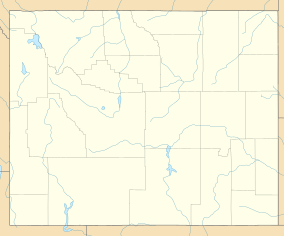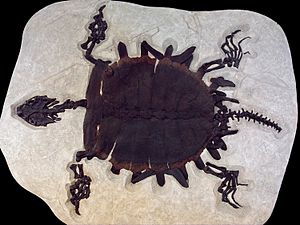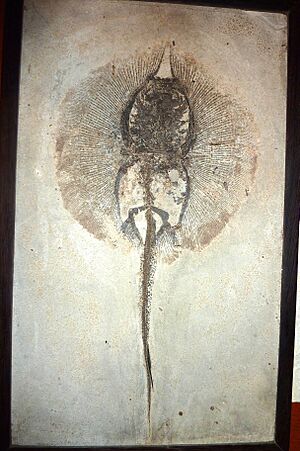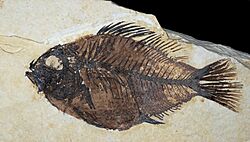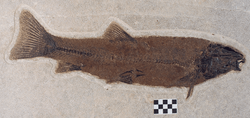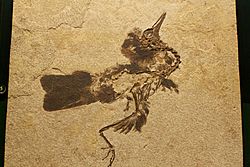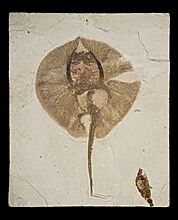Fossil Butte National Monument facts for kids
Quick facts for kids Fossil Butte National Monument |
|
|---|---|
|
IUCN Category V (Protected Landscape/Seascape)
|
|

Fossil Butte National Monument
|
|
| Location | Lincoln County, Wyoming, US |
| Nearest city | Kemmerer, WY |
| Area | 8,198 acres (33.18 km2) |
| Established | October 23, 1972 |
| Visitors | 16,552 (in 2011) |
| Governing body | National Park Service |
| Website | Fossil Butte National Monument |
Fossil Butte National Monument is a special place in Wyoming, United States. It's like a giant outdoor museum managed by the National Park Service. This monument is famous for its amazing collection of ancient animal and plant fossils.
These fossils are from a time called the Eocene Epoch, which was about 56 to 34 million years ago! They come from a place that used to be a huge body of water called Fossil Lake. This lake was one of three big lakes in what is now Wyoming, Utah, and Colorado. Fossil Butte National Monument was created on October 23, 1972, to protect these incredible discoveries.
The monument holds the best record of ancient water-dwelling creatures from the Cenozoic Era in North America, and maybe even the whole world! These fossils are found in the 50-million-year-old Green River Formation, which is the ancient lake bed. Scientists have found fossils of fish, alligators, bats, turtles, a horse the size of a dog, insects, and many kinds of plants. These fossils tell us that the area was once a warm, wet, subtropical basin with fresh water. The sediments that preserved these fossils built up over about 2 million years.
Contents
Ancient Lakes and Fossil Formation

Millions of years ago, during the Eocene time, this part of Wyoming was a warm, wet place with a huge lake system. This system, called the Green River Lake System, had three ancient lakes: Fossil Lake, Lake Gosiute, and Lake Uinta. These lakes covered parts of Wyoming, Utah, and Colorado.
Fossil Butte is what's left of the deposits from Fossil Lake. This ancient lake was about 40 to 50 miles (64 to 80 km) long and 20 miles (32 km) wide. Its size changed over the 2 million years it existed.
Fossil Buttes National Monument protects about 13 square miles (8,198 acres) of this ancient lake bed. The rock layers that hold most of the fossils are called the Green River Formation. There's also another important rock layer called the Wasatch Formation. This formation contains fossils from the land around the lake, like teeth and bone pieces from early mammals, including ancient primates and horses.
A Look Back in Time: History of Fossil Butte
The discovery of coal for railroads led to the nearby town of Fossil, Wyoming. When people found fossils, miners started digging them up to sell. One famous fossil seller was Lee Craig, who sold fossils from 1897 to 1937.
Today, you can't collect fossils for sale inside the National Monument. However, many private quarries nearby still find amazing fossils. These fossils go to museums and private collectors, helping us learn more about Earth's past.
What You Can See and Do
The Visitor Center at Fossil Butte National Monument is a great place to start your adventure. It has over 80 fossils and fossil casts on display. You can see ancient fish, crocodiles, turtles, bats, birds, insects, and plants.
There's also a short video that explains the fossils found here and what scientists have learned from them. You can even make your own fossil rubbings to take home! Computer programs teach you about fossils, geology, and the animals and plants that live there today.
Fun Activities for Kids
If you visit in the summer, you might see park staff preparing fossils right in front of you! Summer is also a great time for ranger programs, guided hikes, and talks about paleontology (the study of fossils) and geology (the study of Earth's rocks). You might even get to help collect fossils for the park!
Kids aged 5–12 can join the Junior Ranger program. It takes about 3–4 hours to complete, with activities designed for different ages. A highlight is hiking up the butte to a real fossil dig site. Here, interns from the Geological Society of America will tell you about their work. They might even let you help carefully split open sedimentary rocks to find fish fossils or even coprolites (fossilized animal poop!).
Amazing Ancient Life: Fossils Found Here
Fossil Butte National Monument is a treasure chest of ancient life. Here are some of the cool creatures and plants that once lived here:
- Fish: Many types of fish have been found, including extinct stingrays like Asterotrygon and Heliobatis radians. There are also Knightia fish, which are related to modern herring, and a large predatory paddlefish called Crossopholis magnicaudatus.
- Amphibians: Scientists have found fossils of extinct salamanders and frogs.
- Mammals: Imagine a horse the size of a dog! That was Protorohippus, an early horse-like mammal. There were also ancient bats like Onychonycteris finneyi, otter-like carnivores, and small omnivores.
- Birds: Fossils of ancient frigate birds, shoreline birds, and even four extinct species of parrot have been discovered.
- Reptiles: This area was home to many reptiles, including extinct anoles, small snakes, and several kinds of lizards. There were also ancient crocodiles and many types of turtles, including large soft-shell turtles.
- Plants: The ancient lake was surrounded by lush plant life. Fossils of palm trees, cattails, and various ferns like the staghorn fern Platycerium have been found. There were also plants similar to walnuts and soapberry trees.
- Arthropods: Even tiny creatures left their mark! Fossils of extinct shrimp and crayfish have been found. Scientists have also discovered ancient spiders, dragonflies, damselflies, crickets, and other insects like bees and ants.
Gallery
-
Cockerellites liops from Fossil Lake. An extinct perch. About 11.5 cm (4.5 in) long.
-
An unidentified fossil bird from FBNM, in the collections of the Field Museum
-
A well-preserved Buprestidae beetle (3.5 cm (1.4 in) long) from the FBNM collections. Other beetles, flies and Hemiptera bugs have also been found in the Fossil Lake sediments.
-
Heliobatis radians, an extinct stingray, had small teeth for crushing snails and other mollusks and barbed spines on the tail for defense. This specimen is about 35 cm (14 in) long, including the tail.
See also
Other NPS Cenozoic Era sites in the western U.S.:
- John Day Fossil Beds National Monument, Oregon
- Hagerman Fossil Beds National Monument, Idaho
- Agate Fossil Beds National Monument, Nebraska
- Badlands National Park, South Dakota
- Florissant Fossil Beds National Monument, Colorado


